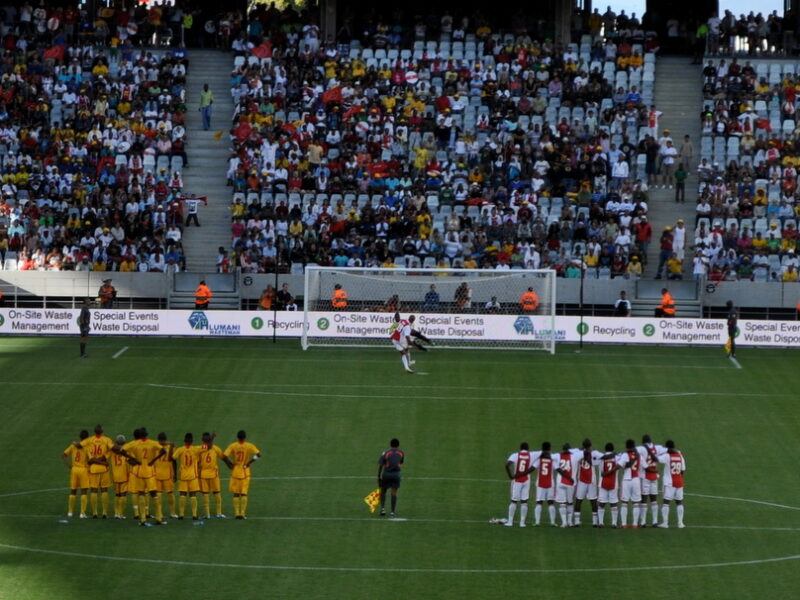To win a cup competition, you will need to beat another team in the final.
However, while teams will set up to win the game in the 90 minutes.
Not all the time, can they be separated in normal time.
With the stakes on the line, finals can sometimes be quite cagey, making a draw a common outcome.
Now of course if someone doesn’t score, then nobody will win the final, and therefore the cup.
Here I take you through exactly what happens when a final football match ends in a draw.
Table of Contents
Why Does A Final End In A Draw?
A draw in a final will happen when either no team’s score or the amount goals scored by each team is equal.
For example, if after 90 minutes the game is 0-0, 1-1, 2-2, etc.
Then normal time is, therefore, a tie.
Meaning play must continue to after normal time to get a winner.
Now getting into a final, is no easy task, and having played football for years I have experienced what it takes to get there.
You typically have to win several matches.
Either in a row if its a knockout tournament.
Or the majority if its a round-robin like the World Cup and Champions League for example.
So a result, when teams get to finals, they tend to set up defensively and play more reserved, so that they don’t open up to being scored on the counter.
Now, what better example to use than the biggest international tournament in the world, the World Cup.
With no home advantages, neutral grounds, and of course for one of the grand prizes in football these games hardly ever see goals and therefore end up as draws quite a lot.
If we look at the history of the world cup finals, out of the past 10 editions from 1978 to 2018, the World Cup was tied after 90 minutes 5 out of 10 times.
In fact, only one of the last 4 finals, ended with a winner after 90 minutes.
This just shows you how its common for a draw to happen, and for teams to struggle to get the better of their opponents in a final.
What Happens When A Football Final Ends In A Draw?
When a football final ends in a draw, it is normally followed by extra time in order to determine a winner.
However, what happens after the game is tied, all depends on the rules of the competition.
This is because some are different to others, in this section I will show you all the scenarios that happen when 90 minutes doesn’t split two sides.
1. Nothing Happens
This isn’t the case, for many competitions, however, it does happen especially in leagues in South America.
The reason for this is, finals take place over two legs, instead of just having one.
Due to this each team is able to play one game each at home, with the winner being determined by an aggregate score.
So this means the first leg of the final can finish as a draw, and no extra play is needed.
If the second leg ended with the goals being tied, then the game would be settled by either extra time or penalties depending on the rules of the competition.
As I said none of the European competitions have adopted this concept, its more popular in America.
With the Liga MX using it to determine the winner of both the Clausura and Apertura in Mexico.
Along with being used in other American leagues, it was used for the Copa Libertadores.
However, they changed it in 2016 to go to a one-leg game instead of a two-legged one.
Extra Time
The most common thing to happen after a final finishes level is to go to extra time.
Extra time means another 30 minutes of uninterrupted play, in order to find a winner.
Its the final attempt to split two teams in open play before a penalty shootout is then brought into the equation.
For extra time, teams will play two halves of 15 minutes, with a short halftime break.
Golden Goal
Golden Goal was a tried and tested concept in the early noughties.
It isn’t used anymore in football, however, it was used in the 2004 World Cup Final in Korea and Japan.
The concept of golden goal is very similar to extra time, as in you play an extra half an hour, split in too two.
However the only difference is that its first goal wins, so the first team to hit the net in this time period will win the game.
Its a devastating way to win a game, and while its still very much big part of sports like American Football, it was stopped after that 2004 competition.
Switching back to the original extra time as spoken about above.
Penalty Shootout
In the case, that there is still no winner, and both teams are drawing after extra time, then a penalty shootout will take place.
With a penalty shootout, each team has 5 attempts at a penalty kick, with 5 different kickers.
The team that scores more than the other will win the shootout.
Now if two teams still remain level after 5 penalties each with scorelines, such as 5-5, 4-4, etc, then it becomes sudden death.
For sudden death, its essentially the first team to score after the other team fails too.
So if let’s say Team A steps up and scores to make it 6-5 in sudden death.
But then the player for Team B misses their penalty, then Team A wins the final.
Its one of the cruelest ways to lose a final, with many people labeling it as a ‘lottery.
However, it, unfortunately, becomes necessary if two teams refuse to be split.


 5 Things That Happen When A Football Team Gets Relegated
5 Things That Happen When A Football Team Gets Relegated